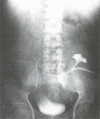Extensive ureteral stricture in renal transplant recipients: prevalence and impact on graft and patient survival
- PMID: 25013670
- PMCID: PMC4089324
Extensive ureteral stricture in renal transplant recipients: prevalence and impact on graft and patient survival
Abstract
Extensive ureteral stricture (EUS) after renal transplantation (RTx) is an important urological complication that adversely affects the longterm function of the allograft and therefore the morbidity and mortality of the recipients. We conducted this study to determine the prevalence of the EUS in RTx recipients and its impact on the patient and graft survival. We assessed retrospectively, 1450 patients who underwent renal transplantation by a fixed surgical team between December 1991 and December 2009 at Emam Reza Hospital, Mashhad University of Medical Science, Mashhad, Iran. EUS was diagnosed in 13 (1.1%) patients including 8 (61.5%) male. The mean±SD age of patients at the time of surgery was 33.6±13.7 years; the length of follow-up was 77.9±63.5 months; and the ischemic time was 126.5±114.1 min. Mostly, EUS was noticed in recipients of transplants with more than one artery (p<0.05) and of cadaveric donors with more than 4 hour ischemic time (p<0.001). In follow-up, after ureteropyelostomy (7 cases), ipsilateral pyelopyloplasty (4 cases) and contralateral pyelopyeloplasty (2 cases), no evidence of ureteral stricture recurrence, graft loss or death was observed. We concluded that the incidence of EUS, as a urologic complication after RTx is very low. The advanced techniques of RTx that preserve the ureteric blood supply and the better procedures for ureteral reconstruction have improved the survival rate of patient and graft.
Keywords: Prevalence; Renal transplant; Survival; Ureter.
Figures
Similar articles
-
[Ureteral stricture following renal transplantation: risk factors and surgical management].Beijing Da Xue Xue Bao Yi Xue Ban. 2014 Aug 18;46(4):548-51. Beijing Da Xue Xue Bao Yi Xue Ban. 2014. PMID: 25131468 Chinese.
-
Minimally-Invasive Ureteral Reconstruction for Ureteral Complications of Kidney Transplants.Urology. 2019 Apr;126:227-231. doi: 10.1016/j.urology.2019.01.002. Epub 2019 Jan 14. Urology. 2019. PMID: 30654141
-
Surgical complications in live-donor pediatric and adolescent renal transplantation: study of risk factors.Pediatr Transplant. 2005 Feb;9(1):33-8. doi: 10.1111/j.1399-3046.2005.00244.x. Pediatr Transplant. 2005. PMID: 15667608
-
Clinical outcomes after ABO-incompatible renal transplantation: a systematic review and meta-analysis.Lancet. 2019 May 18;393(10185):2059-2072. doi: 10.1016/S0140-6736(18)32091-9. Epub 2019 Apr 18. Lancet. 2019. PMID: 31006573
-
Outcomes in Renal Transplant Recipients With Lupus Nephritis-A Single-Center Experience and Review of the Literature.Transplant Proc. 2016 Jun;48(5):1489-93. doi: 10.1016/j.transproceed.2016.02.061. Transplant Proc. 2016. PMID: 27496433 Review.
Cited by
-
Effect of ureteral stricture in transplant kidney and choice of treatment on long-term graft survival.Int Urol Nephrol. 2023 Sep;55(9):2193-2203. doi: 10.1007/s11255-023-03669-z. Epub 2023 Jun 12. Int Urol Nephrol. 2023. PMID: 37308613 Free PMC article.
References
-
- Akbar SA, Jafri SZH, Amendola MA, Madrazo BL, Salem R, Bis KG. Complications of renal transplantations. Radiographics. 2005;25:1335–56. - PubMed
-
- Praz V, Leisinger HJ, Pascual M, Jichlinski P. Urological complications in renal transplantation from cadaveric donor grafts: A retrospective analysis of 20 years. Urol Int. 2005;75:144–9. - PubMed
-
- Kocak T, Nane I, Ander H, et al. Urological and surgical complications in 362 consecutive living relating donor kidney transplantations. Urol Int. 2004;72:252–6. - PubMed
-
- Yu HL, Ye LY, Lin MH, et al. Treatment of benign ureteral stricture by double J stents using high-pressure balloon angioplasty. Chin Med J (Engl). 2011;124:943–6. - PubMed
-
- Bachar GN, Mor E, Bartal G, et al. Percutaneous balloon dilatation for the treatment of early and late ureteral strictures after renal transplantation: long-term follow up. Cardiovascular Interventional Radiol. 2004;27:335–8. - PubMed
LinkOut - more resources
Full Text Sources


